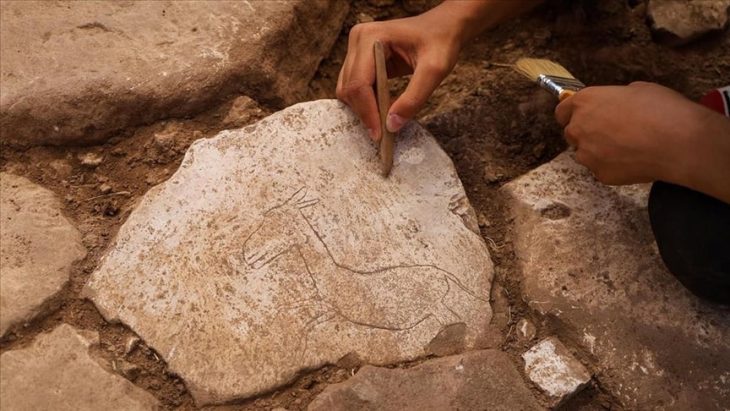During ongoing excavations at Karahan Tepe, a Pre-Pottery Neolithic site in the Şanlıurfa province of southeast Türkiye, archaeologists made a remarkable discovery: a carved depiction of a running wild donkey on a stone. This site, part of the broader Taş Tepeler (Stone Hills) region, is becoming increasingly significant for understanding early human civilization, with its unique stone structures and intricate carvings.
Karahan Tepe is one of several Pre-Pottery Neolithic sites located within the Taş Tepeler region, known for its T-shaped anthropomorphic pillars. This region, situated just 23 miles (37 kilometers) southeast of the famed Göbekli Tepe, continues to offer vital insights into the Neolithic period, particularly with its large collection of more than 250 T-shaped obelisks uncovered to date.
In the 2024 excavation season, the excavation team, led by Professor Dr. Necmi Karul, uncovered a depiction of a running wild donkey on one of the stones paving the floor of a building at Karahan Tepe. Speaking to an AA correspondent, Prof. Dr. Karul explained that the ongoing work is part of the broader Taş Tepeler project, which includes excavations at ten different sites, including Karahan Tepe.
This year’s excavations focused on public buildings and huts surrounding the central structure of Karahan Tepe. One of these buildings, which was only recently uncovered, is partially sunken into the ground and features a wattle and daub roof system atop short stone walls. The building’s floor was paved with large, flat stones, some of which were used as grinding stones. It was on one of these grinding stones that the team discovered the wild donkey motif.
Prof. Dr. Karul emphasized the significance of animal iconography during this period, explaining that animals played an essential role in the symbolic and everyday lives of the people at Karahan Tepe. He noted that the animals depicted in the site’s art could be divided into two categories: those emphasizing fear and power, often seen on the obelisks, and those representing animals commonly consumed and lived with, such as birds, gazelles, and wild donkeys.
The depiction of the running wild donkey is especially intriguing because it is the first time such a moving figure has been found at Karahan Tepe. Previous excavations at Göbekli Tepe had revealed some animal figures on building bases, but this dynamic carving of a wild donkey is unique. Prof. Dr. Karul highlighted the artistry involved, noting that the figure was carved in proportion to the stone on which it was found, showcasing the skill of the period’s artists.
The carved figure measures approximately 20 centimeters in length and was found positioned right next to a grinding stone. While small in size, its dynamic nature and precise proportions indicate the sophisticated craftsmanship of the Neolithic artists. This discovery adds another layer to the understanding of the complex relationship between humans and animals during this era.

The structures currently being excavated at Karahan Tepe date back approximately 11,000 years, and the presence of grinding stones within these buildings suggests that they were used for daily life activities. However, the inclusion of animal depictions and obelisks in these spaces indicates that these buildings also had symbolic or ceremonial significance.
Prof. Dr. Karul expressed optimism about finding more carvings as the excavation continues. Many of the hut structures at the site have not yet been fully explored, and the excavation team is gradually deepening their work to uncover additional layers. The possibility of discovering similar carvings and artifacts remains high as they reach the floor levels of other buildings.
Mehmet Nuri Ersoy, Türkiye’s Minister of Culture and Tourism, shared his excitement about the ongoing work at Karahan Tepe on social media, highlighting the site’s importance as one of the most significant Neolithic settlements. He emphasized that the discoveries at Karahan Tepe, as part of the Taş Tepeler project, continue to shed light on world history, deepening our understanding of the origins of human civilization.
This latest discovery at Karahan Tepe adds to the growing body of evidence that the site was a center of early human activity, rich in both daily life and symbolic meaning. The depiction of the running wild donkey, carved with such precision and artistry, further underscores the sophistication of the people who lived in this region during the Neolithic period.
